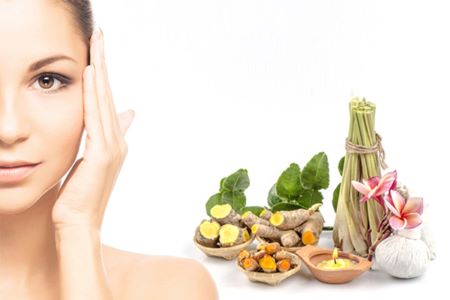In the quest for beauty and vitality, our skin often serves as the canvas upon which our inner vitality is reflected. Yet, in the hustle and bustle of modern life, our skin health can become imbalanced, manifesting various issues such as acne, dryness, or inflammation. In the realm of holistic healing, Ayurveda offers profound insights and remedies for nurturing radiant skin health. Having healthy skin doesn’t have to come at a high cost; in fact, it’s about prioritizing self-care on the inside. Understanding Ayurveda’s Approach to Skin Health Ayurveda views the body as a microcosm of the universe, composed of the five elements (Panchamahabhutas) – earth, water, fire, air, and ether – manifesting in the form of three Doshas: Vata, Pitta and Kapha. According to Ayurveda, imbalances in these Doshas can lead to various skin issues; therefore, restoring harmony to the Doshas is vital in promoting skin health. Vata: Governed by the elements of air and ether, Vata is responsible for movement and dryness in the body. Imbalances in Vata can manifest as dry, rough, or flaky skin, as well as conditions like eczema or psoriasis. Pitta: Representing the elements of fire and water, Pitta governs metabolism and digestion. When Pitta is aggravated, it can manifest as inflammation, redness, or sensitivity in the skin, as well as conditions like acne or rosacea. Kapha: Composed of the elements of earth and water, Kapha governs structure and stability in the body. Imbalances in Kapha can lead to oily, congested skin, as well as conditions like cystic acne or blackheads. Ayurvedic Skincare Rituals In Ayurveda, skincare is not just about external treatments but also about nurturing balance from within. Here are some skincare routines that can promote radiant skin health as per Ayurveda: Cleansing: Gentle cleansing is essential for removing impurities and maintaining skin health. Ayurvedic cleansers often incorporate natural ingredients like rose water, neem or chickpea flour to purify and nourish the skin without stripping away its natural oils. Nourishing: After cleansing, it’s essential to nourish the skin with hydrating and rejuvenating oils. You can use organic sesame oil or even Adirekha Ayurveda Glow Oil which promotes healing and enhances the skin’s natural radiance. Exfoliating: Regular exfoliation helps remove dead skin cells and promote cell turnover, revealing smoother, brighter skin underneath. Ayurvedic exfoliants may include ingredients like oatmeal, rice flour, or lentil powder, which gently slough away impurities and stimulate circulation. Masking: Herbal masks are an integral part of Ayurvedic skincare, offering targeted treatment for specific skin concerns. Ingredients like clay, aloe vera, or rose petals can be combined with Ayurvedic herbs to detoxify, hydrate or soothe the skin, depending on individual needs. Ayurvedic Diet and Lifestyle Tips for Skin Health In addition to external skincare rituals, Ayurveda emphasizes the importance of nourishing the skin from within through diet and lifestyle practices. Here are some Ayurvedic tips for promoting radiant skin health. Eat According to Your Prakriti and Dosha Imbalance: Ayurveda recognizes that each individual has a unique constitution or Prakriti, which influences their dietary needs. By eating foods that align with your Prakriti and pacify your dominant Dosha while balancing the others, you can support optimal skin health. Stay Hydrated: Adequate hydration is crucial for skin health. Drinking plenty of water throughout the day helps flush out toxins, keep the skin hydrated, and maintain its elasticity and suppleness. Manage Stress: Chronic stress can exacerbate skin issues by triggering inflammation and hormonal imbalances. Practicing stress-reduction techniques like yoga, meditation, or deep breathing can help calm the mind; furthermore, they can also promote skin healing from within. Get Quality Sleep: Adequate sleep is essential for skin regeneration and repair. Aim for 7-8 hours of quality sleep each night to allow your skin to rest, rejuvenate, and replenish its natural glow. Ayurvedic recipe for natural skin care This is a recipe from Ashtanga Hridaya for Mukha Dooshika (acne). Ingredients: Multani Mitti Tender guava leaves Turmeric Method of preparation: Make a paste of the main ingredients and rosewater. Apply on your skin thrice a week for 15 minutes. Rinse off with water before it dries up on the skin. In addition, do a Triphala wash three times a day. Multani Mitti/ Earth Clay Multani Mitti is a versatile natural clay; furthermore, it offers a range of potential benefits for your skin. It has deep cleansing and exfoliation properties that absorb excess oil and impurities, unclog pores, and reduce blackheads and whiteheads. It also gently exfoliates, removing dead skin cells and brightening the complexion. Tender Guava Leaves Tender guava leaves have been used in traditional medicine for centuries. Some studies suggest they may offer certain benefits for the skin. Furthermore, guava leaves contain various antioxidants and flavonoids that may help combat free radical damage and, consequently, reduce inflammation. This could contribute to a brighter, healthier-looking complexion. It also has antibacterial and antifungal properties, which could prevent acne-causing bacteria and other skin concerns. Turmeric Turmeric, a vibrant orange spice with a long history of medicinal use, is a natural remedy for acne. Curcumin, the active compound in turmeric, has potent anti-inflammatory effects; therefore, it may play a significant role in reducing inflammation in the body. This could, therefore, help reduce redness, swelling, and irritation associated with acne. Curcumin acts as an antioxidant, protecting the skin from free radical damage that can contribute to acne breakouts. My skincare routine I have acne-prone skin, and therefore, finding the right kind of products that suit my skin has been a struggle until I found them in Ayurveda. Ever since I haven’t looked back. After starting my career and gaining some experience, I now have a line of products that I personally use and recommend to my patients. Here is my daily skincare routine: Step 1- Massaging with organic black sesame oil The first step is cleansing my face with organic black sesame oil. I strongly believe in… Continue reading Skin Health Maintenance With Ayurveda
Skin Health Maintenance With Ayurveda


